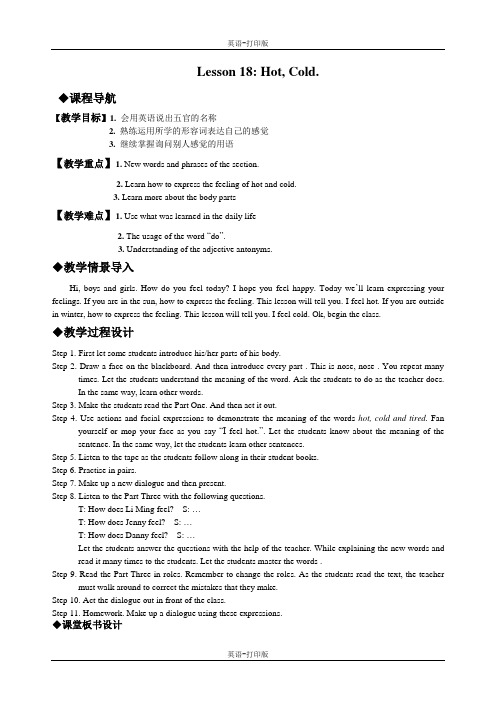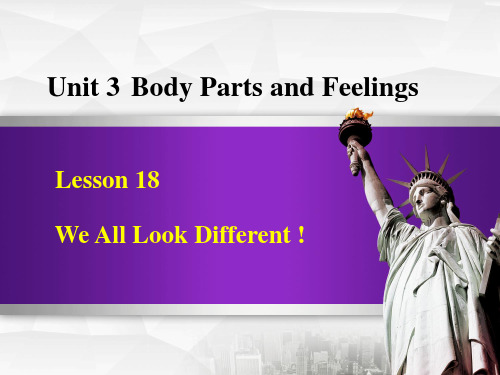冀教版七年级上Lesson 18 Hot,cold
- 格式:ppt
- 大小:759.50 KB
- 文档页数:10

Unit 3 Body and Feelings Lesson18 Hot ,Cold教案强学良Lesson18 Hot ,Cold 说课稿强学良各位评委老师大家好,我说的是冀教版七年级英语第一册第三单元第18课,这一课,我将从以下几个方面谈谈:一、说教材1、教材分析本单元的主要话题是身体部位及五官的名称,描述人的外貌特征并用简单的英语表达自己的情感,此课为本单元的第二节课,主要学习表示五官的单词并描述自己的感受。
2.教学重点指导学生掌握和熟练运用五官的单词、描述自己的感受,如eye,ear,nose,mouth,hot,cold,tired,warm,cool3.教学难点学生根据实际情境需要真正开口讲英语,指导学生口头熟练表达感受的句型以及选择疑问句:How do you feel?Do you feel warm or cool?4.教学目标(1)技能目标学生能听懂对话录音,能听懂师生之间就对话内容而展开的、切形式的问答,会和别人展开对话,了解和传递信息;能就本课语言点造句.(2)知识目标学生要牢记所有新学单词,短语、句型及本对话各句的英语表达,为实现自如讲英语奠定基础。
(3)情感目标通过兴趣教学,使学生要爱学英语、爱说英语、想说英语,对英语学习投以极大的兴趣和热情。
(4)学习策略目标改变传统的死记硬背,积极主动地投入到语言的实践中去,包括听、说、读、写的实践。
在实践中提高语言的综合使用能力,加深对基础知识的掌握和记忆。
二、说教法对本课我主要采取了如下几种教法:1.听录音。
听录音是英语学习的重要方法,也是课堂教学的重要步骤。
在听中感知语言,模仿发音。
2.重点解释,个别操练。
在每一堂教学中,学生总会遇到一些难以理解的词、句型、短语、句子或某一语法现象。
如本课出现的问感受的问句用法都需要教师创设语言情境进行操练和举例,扫除自由交际过程中的“拦路虎”,为语言的进一步学习奠定基础。
3.指导学生展开情景对话。

Lesson 18We All Look Different!Ⅰ.根据句意及首字母或汉语提示完成句子1.We are in d________ classes. He is in Class 5 and I am in Class 4.2.The dog is very c________. Everyone wants to play with it.3.She is ________(十三) years old now.4.It's ________(差不多) ten o'clock.5.This is a ________(有趣的) story.Ⅰ.用所给单词的适当形式填空6.My father wears a pair of ________ (glass).7.The little boy ________ (look) so cute.8.________(she) eyes are blue. They are so beautiful.9.My brother is fourteen ________ (year) old.10.He has three hairs. He looks so________ (fun).Ⅰ.单项选择()11.—What does Lisa ________?—She is very pretty.A.look B.look likeC.like D.looks like()12.Nobody is perfect(完美的), and everyone is different ________ others.A.from B.of C.at D.in()13.Jenny ________ from Canada. She ________ blond hair.A.is; doesn't has B.aren't; hasC.is; has D.isn't; have()14.I am a Chinese girl. I have ________ eyes.A. big blackB. black bigC. brown smallD. long blue()15.Wang Mei has short ________. Danny has ten white________.A.hair; hairs B.hairs; hairC.hair; hair D.hairs; hairsⅠ.完形填空Lucy gets up late today. She is not __16__. Her mother touches(触摸) Lucy's __17__. Her head is hot. She asks Lucy, “__18__ do you feel?”“I feel cold,” Lucy says.“Let's go to see a __19__,” her mother says.The doctor asks Lucy, “What's the matter?”“I feel __20__,” Lucy says.“Do you have a headache?” the doctor asks.“Yes, I __21__,” Lucy says.“Do you have a __22__?” the doctor asks.“No,” Lucy says. “But I feel cold.”“__23__ has a cold,” the doctor says to Lucy's mother.“Is it serious?” Lucy's mother asks.“No. Take the medicine and have a rest. She will be well soon,” the doctor says.“__24__,” Lucy's mother and Lucy say. Then they go __25__.()16.A.sad B.happy C.tall D.tired()17.A.arm B.hand C.ears D.head()18.A.What B.How C.Where D.How many()19.A.teacher B.doctor C.worker D.nurse()20.A.cool B.happy C.sick D.warm()21.A.am B.do C.is D.are()22.A.tooth B.head C.stomach D.stomachache()23.A.You B.She C.It D.He()24.A.How are you B.Thank you C.Here you are D.You're welcome()25.A.home B.library C.school D.classroomⅠ.任务型阅读This is a nice girl in the school. She is 13 years old. She is a bit fat. She wears glasses and she looks pretty. She is not tall. She has a round face. She has two big black eyes and a small nose. Her mouth is big, but her ears are small. She has short black hair. Her favourite colour is red. She has a little black dog in her home. She and the dog are good friends.26、27题完成句子;28题简略回答问题;29题找出并写下全文的主题句;30题将文中画线句子译成汉语。

步骤3:Brainstorm:Can you think of some adjectives(形容词) to describe a person?beautiful, good-looking, cool, cute,able, active, alert(机灵的), confident, creative(富有创造力的), cooperative, careful, friendly, hard-working, gentle(有礼貌的), honest, humorous, independent (有主见的), kind, warm-hearted,modest, reliable(可信赖的), selfish(自私的), smart(精明的), strict, easygoing(随和的), pretty, ugly(丑陋的), handsome, good-natured(性格好的), different, funny…设计意图:通过头脑风暴让学生回忆描述人物的形容词,为本课的学习做准备。
步骤4:Learn the new words.通过语篇学习生词。
different [ˈ difrənt] adj. 不同的(反义词same,名词形式difference)be different from------be the same asThey look different.They have different hobbies. They have different hair styles.What makes you different?cute[kju:t] adj. 逗人喜爱的,漂亮的1. The rabbit looks so cute. I really want to tough its fur.第二课时一、教材分析本单元主要是围绕谈论时间和喜爱的学来展开话题,通过本单元的学习,使学生了解时间的表达方法和学的学习方法的相关情况,乐于接触并了解异国文化。

Lesson 18: Hot, Cold.◆课程导航【教学目标】1. 会用英语说出五官的名称2. 熟练运用所学的形容词表达自己的感觉3.继续掌握询问别人感觉的用语【教学重点】1. New words and phrases of the section.2. Learn how to express the feeling of hot and cold.3. Learn more about the body parts【教学难点】1. Use what was learned in the daily life2. The usage of the word “do”.3. Understanding of the adjective antonyms.◆教学情景导入Hi, boys and girls. How do you feel today? I hope you feel happy. Today we’ll learn expressing your feelings. If you are in the sun, how to express the feeling. This lesson will tell you. I feel hot. If you are outside in winter, how to express the feeling. This lesson will tell you. I feel cold. Ok, begin the class.◆教学过程设计Step 1. First let some students introduce his/her parts of his body.Step 2. Draw a face on the blackboard. And then introduce every part . This is nose, nose . You repeat many times. Let the students understand the meaning of the word. Ask the students to do as the teacher does.In the same way, learn other words.Step 3. Make the students read the Part One. And then act it out.Step 4. Use actions and facial expressions to demonstrate the meaning of the words hot, cold and tired. Fan yourself or mop your face as you say “I feel hot.”. Let the students know about the meaning of the sentence. In the same way, let the students learn other sentences.Step 5. Listen to the tape as the students follow along in their student books.Step 6. Practise in pairs.Step 7. Make up a new dialogue and then present.Step 8. Listen to the Part Three with the following questions.T: How does Li Ming feel? S: …T: How does Jenny feel? S: …T: How does Danny feel? S: …Let the students answer the questions with the help of the teacher. While explaining the new words and read it many times to the students. Let the students master the words .Step 9. Read the Part Three in roles. Remember to change the roles. As the students read the text, the teacher must walk around to correct the mistakes that they make.Step 10. Act the dialogue out in front of the class.Step 11. Homework. Make up a dialogue using these expressions.◆课堂板书设计Lesson 18: Hot, Coldhot, cold, warm, nose, mouth, eye, ear, very, tied,Are you hot? Yes,I’m very hot./ No,I’m not hot.I am very happy.I like your car very much.◆作业1. Finish the remaining exercises in the activity book.2. Preview the next reading in the student book.3. Encourage the students to communicate using these expressions.●教学反思英语教师的教学重点是放在教学内容,教学大纲和考试形式上呢,还是将教学注重点转移到学生的性格、兴趣、情绪等方面的培养和控制?我作为一名英语教师认为“民主、开放、平静、友好、体贴、乐于助人、聪明、富于逻辑性和快乐的教学”是现代的教学趋势,其学习英语成功的可能性要大于与上述性格相反或相差极大的学习者。

Lesson 18 Hot, ColdTarget language目标语言Words and phrases 生词和短语hot, cold, warm, cool, nose, mouth, eye, ear, very, tired, ouchAbility goals 能力目标Enable students to know four words of the body parts: nose, eye, mouth, ear and the expressions of talking about the feelings: hot, cold, warm, cool, tired.Learning ability goals学能目标Help students grasp the words: nose, eye, mouth, ear and express their feelings.Teaching important points 教学重点Learn the important words: nose, eye, mouth, ear, hot, cold, warm, cool and tired.Teaching difficult points 教学难点Learn the important sentence: Do you feel cold or warm?Teaching methods 教学方法Reading and speaking.Teaching aids 教具准备Audiotape.Teaching procedures & ways 教学过程与方式Step I Revisiona. Greetingb. Sing the song in the last lesson together.c. Ask and answer.T: I’m very happy. How do you feel? Do you feel happy too?Ss: Yes. I’m happy, too.T: That’s very good.d. Look and sayThe teacher touches the different parts of the body and let the students say the words.Step II PresentationPoint to eye, nose, mouth, ear and say the words.T: (Point to one eye.) Eye. It’s an eye. Say eye.Ss: Eye.Present other words in the same way.Step III Practicea. DrillT: This is my mouth.Ss: This is my mouth.T: (Point to a boy’s mouth.) This is his mouth.Ss: This is his mouth.T: (Point to a girl’s mouth.) This is her mouth.Ss: This is her mouth.b. Listen to the tape and repeatc. LearnTell students several idioms about “eye”. Here are some examples:eye for eye. (以眼还眼)Cry one’s eyes out. (痛哭流涕)Have an eye for. (很能鉴赏)Eyes front. (向前看)Eyes left. (向左看)Step IV PresentationUse actions and facial expressions to demonstrate the meaning of the words: hot, cold, warm, cool and tired.T: (Fan myself and mop my face ) Hot!!! I feel hot. I am very hot.Ss: I’m very hot.Use other actions to show other words.Step V Practicea. Listen to the tape and repeatb. Listen and act.Listen to what the teacher says about feelings and act out the actions and facial expressions.c. Role-play the dialogue.Step VI PresentationAsk and answer with some actions and facial expressions to learn “Do you feel ____ or ____?”T: (Fan myself and mop my face.) Do I feel cold or hot?Ss: You feel hot.T: (Fan a student.) Do you feel you cool or warm?S1: I feel cool.Step VII Practicea. Listen and answerListen to the tape and answer the following questions.1. How does Li Ming feel? (Warm. / He feels warm.)2. How does Jenny feel? (Cool. / She feels cool. )3. How does Danny feel? (Hot. / He feels hot. )b. Listen to the tape and repeat.c. Make up a similar dialogue and showStep VIII Homeworka. Finish the exercises in the activity book.b. Practice the dialogue in pairs.c. Preview Lesson 19.。
